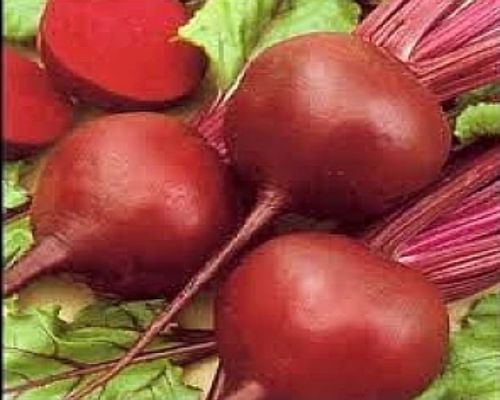
BEET ROOT HYBRID LALIMA (ADVANTA)
|
Hybrid
Beet Root LALIMA |
|
|
Plant Habit |
Erect |
|
Root Shape |
Globe |
|
Root Colour |
Red |
|
Root Weight |
180-200 g |
|
Maturity |
60-65 DAS |
|
Season |
Rabi |
|
Special Features |
Suitable for both fresh
market and processing |
|
Cultural Beet Root |
|
|
Season |
Mid Aug - Dec |
|
Climate |
It grows well in warm
weather, but it attains best colour, texture & quality in a cool weather.
Excessive lt hot weather causes - zoning - the appearance of alternating
light & dark red concentric circles in the root. They are sensitive to
low temperature 0 0 (4.5 -10 C), if exposed to such temperature for 15 days,
bolting likely to occur before the roots reach marketable size. Requires
abundant sunshine for development of storage roots. |
|
Nursery |
Direct Sowing |
|
Soil & Land Preparation |
Deep, well drained
loams/sandy loams are considered best. In heavy soils- roots are likely to be
unsymmetrical in shape, also results in poor stand as seedlings may not come
out due to formation of hard earth crust, in rainy season. Sensitive to soil
acidity (below-5.8 pH). It is one of the few vegs. that can be successfully
grown in saline soils |
|
Seed Rate |
2 kg/acre |
|
Irrigation |
Irrigate as & when
required based on the soil type & the local practices. |
|
Spacing |
Row to Row : 40 cm &
Plant to Plant : 10 cm |
|
Fertilizer Kg/Acre |
NPK - 25:40:25 |
|
1st Picking |
Maturity in 65-70 days |
|
Growth Regulator |
Apply manganese sulphate
when grown in alkaline soil. |
|
Yield T/ha |
15-20 T |
|
Avg. per Fruit Weight (g) |
125 g |
|
Major Impediment |
i) Internal black spot /
brown heart (Disorder): Bo deficiency / long dry spell - followed by wet
period may cause it. Plant dwarf / stunted, leaves assumes variegated
appearance, twisted with longitudinal splitting. ii) Viral dis: Mosaic /
Curly top / Yellow - vector - Aphids, mottling with chloratic, zonate ring
spots. iii) Beet Leaf Minor: Feeds
on tissues between upper & lower layers of the leaf, making it unfit for
manufacturing of food as a result plant growth completely checked. |
|
Harvesting: |
Harvested as they attain a
diameter of 3-5 cm. They are usually pulled by hand; tops are removed &
after washing the roots are graded according to size. |
|
Key Points |
i) Morphologically, the
upper portion of the root develops from the hypocotyl and the lower portion,
from which the secondary roots arise, develops from the taproot. ii) Inflorescence large
spike, normally develops in the second year, flowers sessile, in cluster of
3-4 |
|
Care |
i) Thinning is an essential
operation, because the seed ball is actually a fruit consisting of 2-6 seeds,
each of which may germinate produce a plant. ii) Irrigation: Deficiency
of water leads to reduction in size. |

